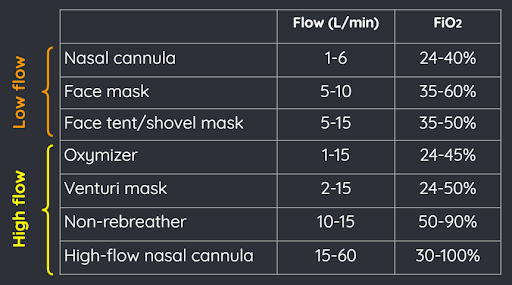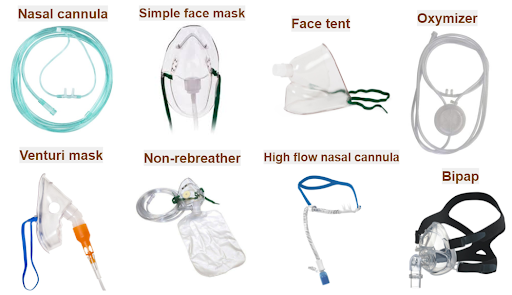It's time for another Tweetorial from @JennyShihMD !
How do you escalate oxygen methods of delivery after nasal cannula? Do you use Oxymizer? Or non-rebreather?
How do you choose which one?
Let’s take a quick dive into oxygen delivery methods. A thread🧵
How do you escalate oxygen methods of delivery after nasal cannula? Do you use Oxymizer? Or non-rebreather?
How do you choose which one?
Let’s take a quick dive into oxygen delivery methods. A thread🧵
Let’s take a step back to oxygen delivery from the lungs to the tissues and oxygen consumption.
Remember that most of the oxygen delivered is bound to hemoglobin and a smaller proportion is dissolved in plasma.
Remember that most of the oxygen delivered is bound to hemoglobin and a smaller proportion is dissolved in plasma.
So while we will focus on increasing partial pressure of oxygen (PaO2) through supplemental O2, it is important to ensure sufficient hemoglobin levels and transfuse red blood cells as needed in acute blood loss. 

There is a wide variety of oxygen delivery systems. Below are many different oxygen delivery devices. Can you identify them? Scroll for answers. 

These devices are commonly classified as low flow or high flow systems based on the flow rate. Low flow systems (nasal cannula, face mask, face tent) are usually < 10 L/m. High flow systems (Oxymizer, Venturi mask, non-rebreather, high-flow nasal cannula) are usually >= 10 L/m. 

They also vary in fraction of inspired oxygen (FiO2) and comfort, humidification, and mouth or nose breathing. 

How much does FiO2 increase with 1 L/min oxygen using nasal cannula?
Many people say that the FiO2 increases by ~3% for every 1L/min increase in oxygen flow. However, FiO2 is quite variable depending on how quickly the patient is breathing. Let’s explore this concept further.
Many people say that the FiO2 increases by ~3% for every 1L/min increase in oxygen flow. However, FiO2 is quite variable depending on how quickly the patient is breathing. Let’s explore this concept further.

FiO2 is determined by the proportion of O2 coming from the supply versus atmospheric air. All of the O2 coming from the supply is 100% O2, whereas the atmosphere is 21% O2. Increasing flow of O2 increases the proportion coming from the oxygen supply, leading to an ⬆️in FiO2. 

Conversely, increasing the peak inspiratory flow rate (PIF) or minute ventilation will increase the proportion of oxygen coming from atmospheric air, leading to a decrease in FiO2.
For example, if you are receiving 5L nasal cannula and have a PIF rate of 30 L/min, your FiO2 is 31%. If the PIF rate increases to 40 L/min with the same oxygen delivery, FiO2 decreases to 28%. 

Now having learned these concepts -- what is your go-to device for acute hypoxemic respiratory failure for a patient on the general medicine wards?
Answer below:
Answer below:
Non-rebreather is a reservoir system that provides close to 100% FiO2 when used with high flow, so it is our preferred device for acute hypoxemic respiratory failure. Of course, the medical ICU should be notified as the patient may be coming their way soon! 

Thanks for reading! Here’s a great resource and summary of oxygen devices. (nejm.org/doi/full/10.10…)
Take-away points:
1⃣Review the flow rate and FiO2 of oxygen devices to choose the best device.
2⃣FiO2 increases by ~3% for every 1L/m increase in O2 flow. BUT this is dependent on inspiratory flow rate.
3⃣Use non-rebreather for acute hypoxemic respiratory failure in non-ICU pts
1⃣Review the flow rate and FiO2 of oxygen devices to choose the best device.
2⃣FiO2 increases by ~3% for every 1L/m increase in O2 flow. BUT this is dependent on inspiratory flow rate.
3⃣Use non-rebreather for acute hypoxemic respiratory failure in non-ICU pts
Thank you so much to @jbricha1 for reviewing -- and of course for @JennyShihMD, digital educator extraordinaire!
• • •
Missing some Tweet in this thread? You can try to
force a refresh










